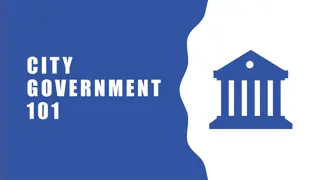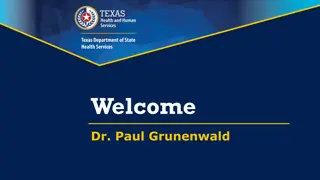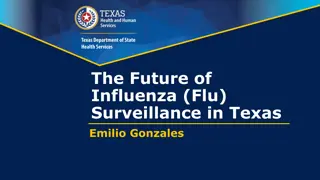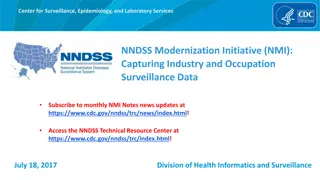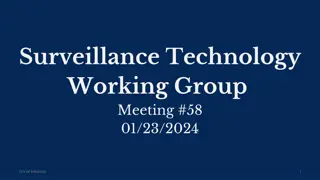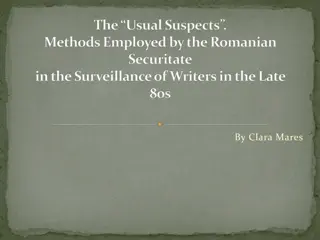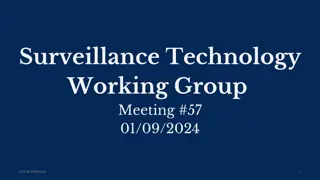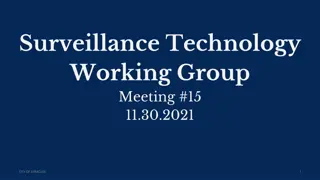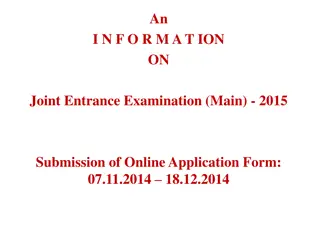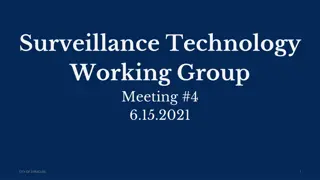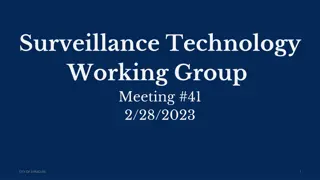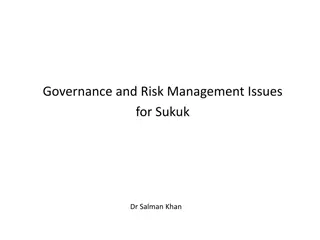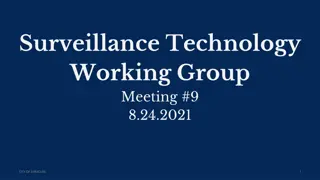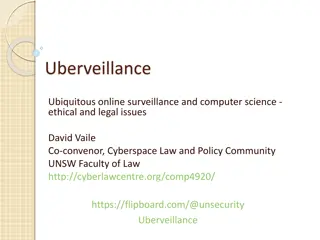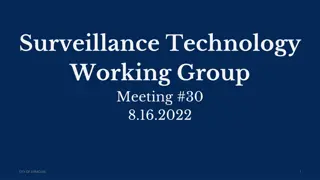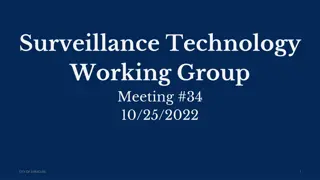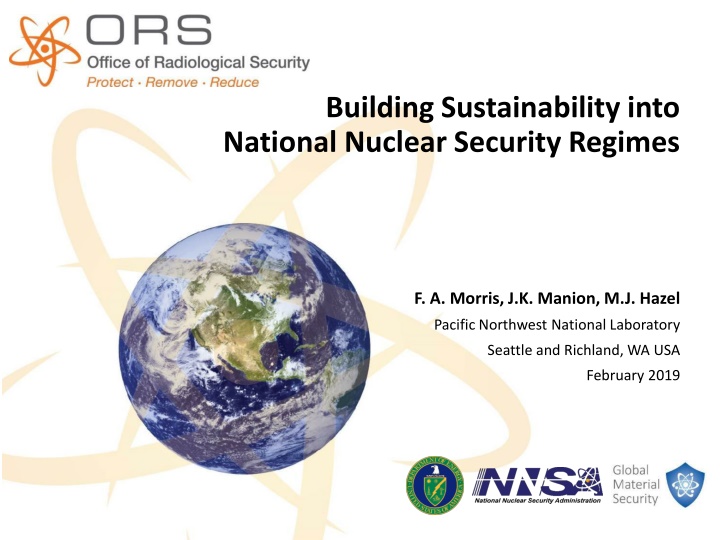
Surveillance Technology Policy and Data Governance 2022 Meeting in City of Syracuse
Agenda includes discussions on Cyclomedia - Right of Way Imaging, review of past decisions including Fotokite and Vacant Lot Monitoring, and review of current decisions such as Samsara and Flock Safety/ALPRs. The meeting also covers internal norms, attendance requirements, and the process for external participants.
Download Presentation

Please find below an Image/Link to download the presentation.
The content on the website is provided AS IS for your information and personal use only. It may not be sold, licensed, or shared on other websites without obtaining consent from the author. If you encounter any issues during the download, it is possible that the publisher has removed the file from their server.
You are allowed to download the files provided on this website for personal or commercial use, subject to the condition that they are used lawfully. All files are the property of their respective owners.
The content on the website is provided AS IS for your information and personal use only. It may not be sold, licensed, or shared on other websites without obtaining consent from the author.
E N D
Presentation Transcript
Building Sustainability into National Nuclear Security Regimes F. A. Morris, J.K. Manion, M.J. Hazel Pacific Northwest National Laboratory Seattle and Richland, WA USA February 2019
Introduction The fundamental basis for nuclear security is each State s nuclear security regime Legislative and regulatory framework Institutions and organizations Nuclear security systems and measures To be sustainable, a nuclear security regime must function effectively over time Continue to exist Continue to protect against nuclear security threats Adapt to changing circumstances Time 2
Meeting the Challenge IAEA Nuclear Security Series No. 30-G, Sustaining a Nuclear Security Regime, provides useful guidance But sustainability is a significant challenge nuclear security regimes have a tendency to lose cohesion over time States may be able to overcome this tendency by building sustainability into the nuclear security regime by building sustainability in through sustainability by design This paper and presentation suggest several building blocks for this purpose and combines them in a notional assessment template 3
Building Blocks Organizational arrangements Regulatory body leadership Nuclear security champions Succession planning Professionalization Nuclear security community Self-assessment National reports International engagement Nuclear security norms 4
Organizational Arrangements Embed nuclear security into the permanent organization of the government Helps ensure that the interest in effective nuclear security is represented in government deliberations, with appropriate weight e.g. by Establishing a nuclear security coordinating body, with a full- time staff, regular budget, and decision-making authority through a defined process Requiring the nuclear regulatory body to take nuclear security considerations into account when making key regulatory decisions, such as siting and licensing Establishing nuclear security units within competent authorities as the intelligence community, law enforcement, customs authorities, and border protection authorities 5
Regulatory Body Leadership Provide for stability and nuclear security expertise in the leadership of the nuclear regulatory body Helps ensure that nuclear security remains a priority within the regulatory body e.g. by Requiring the regulatory body chair and a plurality of the governing board or commission to have nuclear energy expertise, including nuclear security expertise Appoint the chair and the governing board or commission members to fixed multi-year terms (at least five years), with the presumption that they will serve their full terms, and not be replaced upon changes in government 6
Nuclear Security Champions Foster nuclear security champions respected and energetic proponents of effective nuclear security Helps ensure continuing advocacy for effective nuclear security within the regulatory body and other competent authorities e.g. by Recognizing and rewarding champions Including them in State delegations to important international meetings Supporting temporary assignment to the IAEA while enabling them to resume a senior position on their return Designating them as mentors to talented junior staff Retaining them as senior advisors after retirement 7
Succession Planning Establish a process for replacement of departing key nuclear security personnel with qualified successors Helps ensure that the regulatory body and other competent authorities do not face a gap when nuclear security experts depart or retire through a formal process that Identifies key nuclear security positions Identifies necessary qualifications for each position Identifies interested staff and assesses them against qualifications Develops strategies for addressing gaps in qualifications Monitors and evaluates implementation 8
Professionalization Make nuclear security an acknowledged profession, whose practitioners possess specialized expertise Helps develop and renew the pool of qualified practitioners, contributes to continual improvement, attracts talented newcomers, and provides a constituency for effective nuclear security e.g. by Establishing qualification standards for key nuclear security positions Requiring that individuals meet the qualification standards through certification Establishing and financially supporting nuclear security degree programs Encouraging and financially supporting the participation of nuclear security practitioners in the events and programs of such organizations as INMM and WINS 9
Nuclear Security Community Foster a shared interest in effective nuclear security among nuclear security experts and stakeholders Complements professionalization by improving nuclear security, elevating the importance of effective nuclear security within organizations, and by broadening the constituencies for effective nuclear security e.g. through Nuclear security-focused outreach to professional and trade associations in allied fields, such as health physics and law enforcement Nuclear security elective courses in related fields Nuclear security internship programs Rotation of non-nuclear-security staff to nuclear security positions and vice-versa 10
Self-Assessment Establish a process for regularly assessing the effectiveness of the nuclear security regime Helps ensure that gaps in the nuclear security regime are identified and addressed e.g. by Establish a regular national self-assessment process through primary legislation Invite the IAEA to conduct voluntary appraisal mission Complete and regularly update IAEA Nuclear Security Information Management System (NUSIMS) questionnaires Develop and regularly update IAEA Integrated Nuclear Security Support Plans (INSSPs) Require licensee and other operating organizations to conduct their own regular self-assessments Encourage licensee and other operating organizations to use WINS self-assessment tools 11
National Reports Create a requirement for regular national reports on the status of the nuclear security regime Encourages effective performance through the prospect of transparency through primary legislation that Requires a national report at specified intervals (e.g. every four years) Assigns responsibilities for preparing and contributing Specifies the topics to be covered Includes both classified and unclassified versions Requires public dissemination of the unclassified version Is aligned with reporting under UN Security Council Resolution 1540 12
International Engagement Regularly engage on nuclear security with the IAEA, other international organizations, and other States Facilitates the transfer of knowledge and best practices and reinforces the identification of participating individuals with the nuclear security community, e.g. through Permanent IAEA mission that includes nuclear security expertise Participation in the IAEA Incident and Trafficking Database Participation of State experts in IAEA events Donation to the IAEA Nuclear Security Fund and WINS Participation in other international initiatives Regular reporting the United Nations Security Council 1540 Committee 13
Nuclear Security Norms Create an environment in which effective nuclear security is a widely accepted priority, regardless of formal requirements or political considerations Reinforces the formal aspects (such as laws and regulations) through the observance of informal understandings e.g. Nuclear security is not exploited for political advantage Nuclear security positions are filled based on expertise, not influence Changes in nuclear security policies and personnel do not occur solely because of changes in government 14
Assessment Template (1) 2 = Substantial progress 0 = No progress 1 = Some progress Nuclear security responsibilities not assigned within the government Organizational arrangements Some nuclear security responsibilities assigned All nuclear security responsibilities assigned Regulatory body leadership required to include nuclear security experience and expertise; formal measures in place for stability of leadership Process in place to recognize, reward, and develop nuclear security champions Regulatory body leadership not required to include nuclear security experience or expertise Regulatory body leadership required to include nuclear security experience and expertise Regulatory body leadership One or more nuclear security champions identified Nuclear security champions No nuclear security champions identified Succession planning process under development Succession planning No succession planning process in place Succession planning process in place No steps taken to professionalize nuclear security Qualification standards developed for key nuclear security positions Qualification standards developed; certification required Professionalization
Assessment Template (2) 2 = Substantial progress 0 = No progress 1 = Some progress One or two steps taken to build nuclear security community (e.g. outreach) Comprehensive program to build nuclear security community Nuclear security community No steps taken to build nuclear security community Self-assessments at regular intervals required and conducted Single self-assessment completed or planned No self-assessment done Self-assessment Self-assessments at regular intervals required and conducted No self-assessment conducted Single self-assessment completed or planned National reports Regular participation in IAEA meetings and events; participation in at least two other nuclear security initiatives Little or no engagement other than IAEA membership Regular participation in nuclear-security related IAEA meetings and events International engagement Few or no norms Some norms Well developed norms Norms
Conclusions Sustaining an effective nuclear security regime is a challenging task for most States, and requires continual attention, effort, and resources States can increase the likelihood that the necessary attention, efforts, and resources will continue to be available by building sustainability into their nuclear security regimes, to the fullest extent feasible Use of the building blocks and self-assessment template suggested in the presentation and paper can help States achieve this goal PNNL-SA-150137 17

